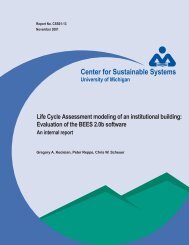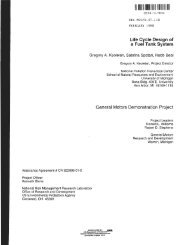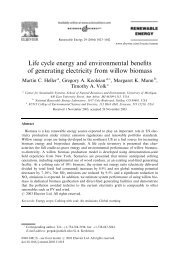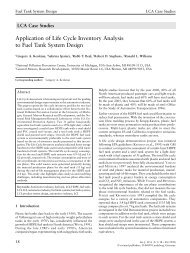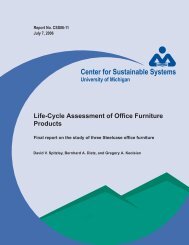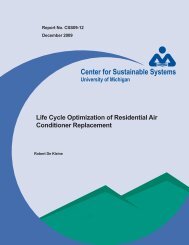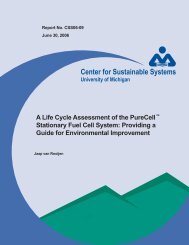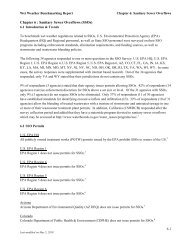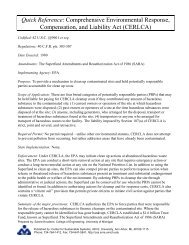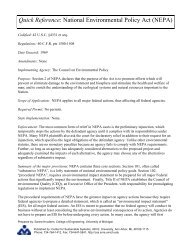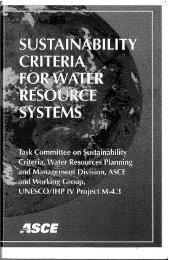Photovoltaic Energy - Center for Sustainable Systems - University of ...
Photovoltaic Energy - Center for Sustainable Systems - University of ...
Photovoltaic Energy - Center for Sustainable Systems - University of ...
You also want an ePaper? Increase the reach of your titles
YUMPU automatically turns print PDFs into web optimized ePapers that Google loves.
PV Installation, Manufacturing, and Cost<br />
• Global cumulative capacity <strong>of</strong> PV systems grew 73-fold between 2000 and 2012, reaching<br />
more than 100 GW. Germany (32 GW), Italy (16 GW), and China (8.3 GW) had the<br />
highest installed PV capacities and made up over half <strong>of</strong> total global capacity. 18<br />
• The U.S. installed 3.3 GW <strong>of</strong> PV in 2012, raising total U.S. PV capacity to 7.8 GW. 18<br />
• PV module prices, a larges part <strong>of</strong> total system cost, fell 62% from 2008 to 2011. 16<br />
• Global investment in solar research and development R&D should further reduce PV<br />
production costs. In 2012, $4.9 billion was invested in solar R&D, higher than any other<br />
renewable energy technology. 19<br />
• PV systems or components are manufactured in 99 factories across 26 states. 14<br />
• Between 2000 and 2010, U.S. market share <strong>of</strong> PV production dropped from 30% to 7%. 20<br />
• PV energy costs range from 15¢ to 64¢/kWh in the U.S., depending on system size. 21<br />
Retail electricity averages 10¢/kWh <strong>for</strong> all users and 12¢/kWh <strong>for</strong> residential. 1<br />
<strong>Energy</strong> Per<strong>for</strong>mance and Environmental Impact<br />
• Net energy ratio compares the life cycle energy output <strong>of</strong> a PV system to its life cycle<br />
primary energy input. One study showed that amorphous silicon PVs generate 3 to 6 times<br />
more energy than are required to produce them. 22<br />
• Recycling multi-crystalline cells can reduce manufacturing energy over 50%. 23<br />
• Although pollutants and toxic substances are emitted during PV manufacturing, life cycle<br />
emissions are low. For example, the life cycle emissions <strong>of</strong> thin-film CdTe are roughly 14 g<br />
CO 2<br />
e per kWh delivered, far below electricity sources such as coal (1,001 g CO 2<br />
e/kWh). 24,25<br />
• PVs can reduce environmental impacts associated with fossil fuel electricity generation; <strong>for</strong><br />
example, thermoelectric plants use 23 gallons <strong>of</strong> water to produce one kWh <strong>of</strong> electricity. 26<br />
U.S. air pollutant emissions were 826.7 kg CO 2<br />
/MWh, 1.8 kg SO 2<br />
/MWh, and 0.8 kg NO x<br />
/<br />
MWh, <strong>for</strong> the 2.87 x 10 9 MWh <strong>of</strong> fossil fuel electricity generated in 2010. 1<br />
Solutions and <strong>Sustainable</strong> Actions<br />
Policies Promoting Renewables<br />
• PV energy costs are currently higher than conventional electricity; however, the price consumers pay <strong>for</strong> electricity does not cover externalities<br />
such as the cost <strong>of</strong> health effects from air pollution, environmental damage from resource extraction, or long-term nuclear waste storage.<br />
Policies that support PVs can address these externalities to make PV energy more cost-competitive. 27<br />
• Proposed carbon cap-and-trade policies would work in favor <strong>of</strong> PVs by increasing the cost <strong>of</strong> fossil fuel energy generation. 28<br />
• PV policy incentives include renewable portfolio standards (RPS), feed-in tariffs (FIT), capacity rebates, and net metering. 29<br />
¤ ¤ An RPS requires electricity providers to obtain a minimum fraction <strong>of</strong> their energy from renewable resources by a certain date.<br />
¤ ¤ A FIT sets a minimum per kWh price that retail electricity providers must pay renewable electricity generators.<br />
¤ ¤ Capacity rebates are one-time, up-front payments <strong>for</strong> building renewable energy projects, based on installed capacity (in watts).<br />
¤ ¤ With net metering, PV owners get credit from the utility (up to their annual energy use) if their system supplies power to the grid.<br />
What You Can Do<br />
• Reduce the total amount <strong>of</strong> energy used in the first place by increasing your energy efficiency.<br />
• Consider installing a PV system <strong>for</strong> your home or business, especially if your state <strong>of</strong>fers capacity rebates or a net metering policy.<br />
• “Green pricing” allows customers to pay a premium per unit <strong>of</strong> electricity that supports investment in renewable technologies. In 2012, more<br />
than 850 utilities nationwide <strong>of</strong>fered green pricing options. 30<br />
• Renewable <strong>Energy</strong> Certificates (RECs) also known as green tags or green certificates, can be purchased in addition to commodity electricity to<br />
“<strong>of</strong>fset” electricity usage and help renewable energy become more competitive. 31<br />
Installed PV Capacity (MW)<br />
Median Installed Price ($/W)<br />
100,000<br />
80,000<br />
60,000<br />
40,000<br />
20,000<br />
12.0<br />
8.0<br />
4.0<br />
0<br />
10.6<br />
10.3<br />
World Cumulative Installed PV Capacity 18<br />
Rest <strong>of</strong> World<br />
U.S.<br />
Median Installed Price,<br />
Residential & Commercial PV <strong>Systems</strong> 16<br />
9.2<br />
≤ 10 kW<br />
10-100 kW<br />
> 100 kW<br />
2002 2003 2004 2005 2006 2007 2008 2009 2010 2011<br />
A watt is a unit <strong>of</strong> power, or a rate <strong>of</strong> energy flow. 1 TW = 1,000 GW = 1,000,000 MW = 1,000,000,000 kW.<br />
A kilowatt-hour is a unit <strong>of</strong> energy. 1 kWh is the electricity energy required to light a 100 watt light bulb <strong>for</strong> 10 hours.<br />
6.1<br />
5.6<br />
4.9<br />
1. U.S. Department <strong>of</strong> <strong>Energy</strong> (DOE), <strong>Energy</strong> In<strong>for</strong>mation Administration (EIA) (2012) Annual <strong>Energy</strong><br />
Review 2011.<br />
2. U.S. DOE, National Renewable <strong>Energy</strong> Lab (NREL) (2012) “<strong>Photovoltaic</strong> Solar Resource <strong>of</strong> the<br />
United States.”<br />
3. Goswami, Y. (2007) <strong>Energy</strong>: The Burning Issue. Refocus, 8(3): 22-25.<br />
4. U.S. EIA (2012) International <strong>Energy</strong> Statistics.<br />
5. America’s <strong>Energy</strong> Future Panel on Electricity from Renewable Resources, National Research Council<br />
(2010) Electricity from Renewable Resources: Status, Prospects, and Impediments.<br />
6. NREL (2012) SunShot Vision Study.<br />
7. U.S. Environmental Protection Agency (EPA) (2011) Renewable <strong>Energy</strong> Ready Home: Solar<br />
<strong>Photovoltaic</strong> Specification, Checklist and Guide.<br />
8. Adapted from NASA Science (2002) “How Do <strong>Photovoltaic</strong>s Work”<br />
9. Photo courtesy <strong>of</strong> National Renewable <strong>Energy</strong> Laboratory, NREL-15610.<br />
10. NREL (2011) “Best Research-Cell Efficiencies.”<br />
11. U.S. DOE, <strong>Energy</strong> Efficiency and Renewable <strong>Energy</strong> (EERE) (2013) “<strong>Energy</strong> Basics: <strong>Photovoltaic</strong><br />
Cells.”<br />
12. U.S. DOE, EERE (2013) “<strong>Energy</strong> Basics: <strong>Photovoltaic</strong> <strong>Systems</strong>.”<br />
13. U.S. DOE, EERE (2013) “<strong>Energy</strong> Basics: <strong>Photovoltaic</strong> Electrical Contacts and Cell Coatings.”<br />
14. Platzer, M. (2012) U.S. Solar Manufacturing: Industry Trends, Global Competition, Federal Support.<br />
Congressional Research Service.<br />
15. U.S. DOE, EERE (2012) “<strong>Energy</strong> Basics: Flat-Plate <strong>Photovoltaic</strong> Balance <strong>of</strong> System.”<br />
16. Barbose, G., et al. (2012) Tracking the Sun V: An Historical Summary <strong>of</strong> the Installed Price <strong>of</strong><br />
<strong>Photovoltaic</strong>s in the United States from 1998 to 2011. Lawrence Berkeley National Laboratory.<br />
17. Mousazadeh, H., et al. (2009) A review <strong>of</strong> principle and sun-tracking methods <strong>for</strong> maximizing solar<br />
systems output. Renewable and <strong>Sustainable</strong> <strong>Energy</strong> Reviews, 13:1800-1818.<br />
18. European <strong>Photovoltaic</strong> Industry Association (2013) Global Market Outlook <strong>for</strong> <strong>Photovoltaic</strong>s 2013-<br />
2017.<br />
19. United Nations Environment Programme (2013) Global Trends in Renewable <strong>Energy</strong> Investment 2013.<br />
20. NREL (2011) PV Manufacturing Cost Analysis: U.S. Competitiveness in a Global Industry.<br />
21. Solarbuzz (2012) “Solar Electricity Prices: March 2012.”<br />
22. Pacca, S., et al. (2007) Parameters affecting life cycle per<strong>for</strong>mance <strong>of</strong> PV technologies and systems.<br />
<strong>Energy</strong> Policy, 35: 3316 – 3326.<br />
23. Muller, A., et al. (2006) Life cycle analysis <strong>of</strong> solar module recycling process. Materials Research<br />
Society Symposium Proceedings, 895.<br />
24. Kim, H., et al (2012) Life Cycle Greenhouse Gas Emissions <strong>of</strong> Thin-Film <strong>Photovoltaic</strong> Electricity<br />
Generation. Journal <strong>of</strong> Industrial Ecology, 16: S110-S121.<br />
25. Whitaker, M., et al. (2012) Life Cycle Greenhouse Gas Emissions <strong>of</strong> Coal-Fired Electricity Generation.<br />
Journal <strong>of</strong> Industrial Ecology, 16: S53-S72.<br />
26. Kenny, J., et al. (2009) Estimated use <strong>of</strong> water in the United States in 2005. U.S. Geological Survey.<br />
27. Fthenakis, V. (2012) Sustainability metrics <strong>for</strong> extending thin-film photovoltaics to terawatt levels.<br />
Materials Research Society Bulletin, 37(4): 1-6.<br />
28. Bird, L., et al. (2008) Implications <strong>of</strong> carbon cap-and-trade <strong>for</strong> U.S. voluntary renewable energy<br />
markets. <strong>Energy</strong> Policy, 36(6): 2063-2073.<br />
29. U.S. DOE, EERE (2011) Solar Powering Your Community: A Guide <strong>for</strong> Local Governments.<br />
30. U.S. DOE, EERE (2013) “The Green Power Network: Buying Green Power.”<br />
31. U.S. DOE, EERE (2012) “The Green Power Network: Green Power Markets: Renewable <strong>Energy</strong><br />
Certificates.”<br />
Cite as: <strong>Center</strong> <strong>for</strong> <strong>Sustainable</strong> <strong>Systems</strong>, <strong>University</strong> <strong>of</strong> Michigan. 2013. “<strong>Photovoltaic</strong> <strong>Energy</strong> Factsheet.” Pub. No. CSS07-08. October 2013



